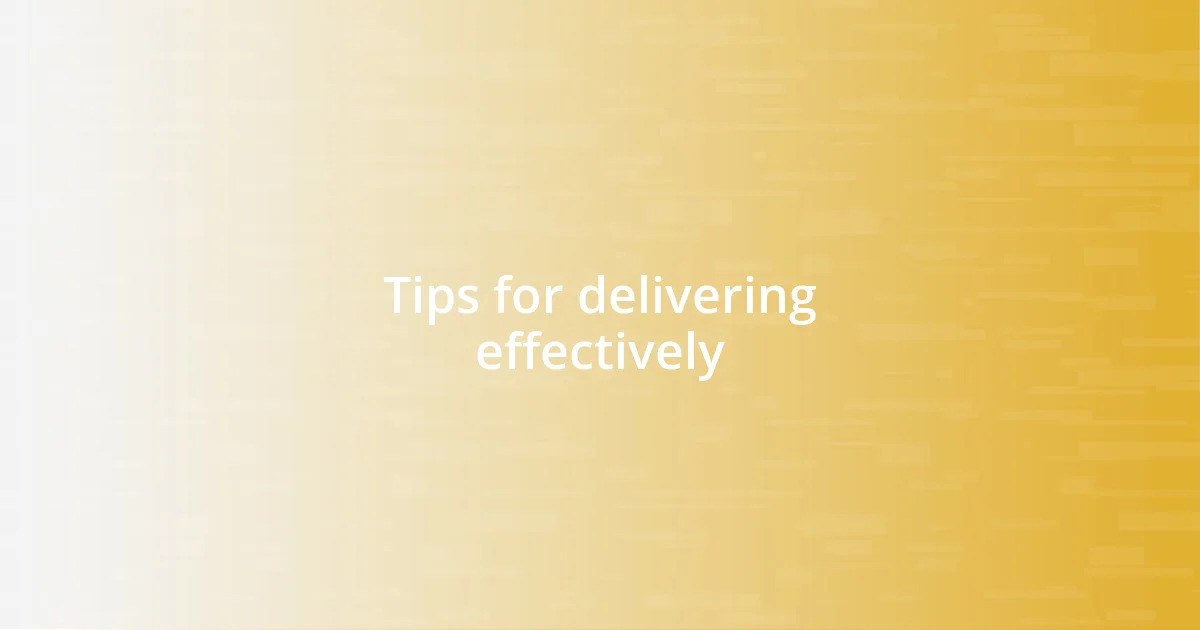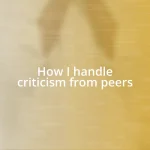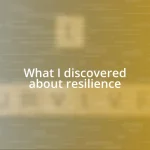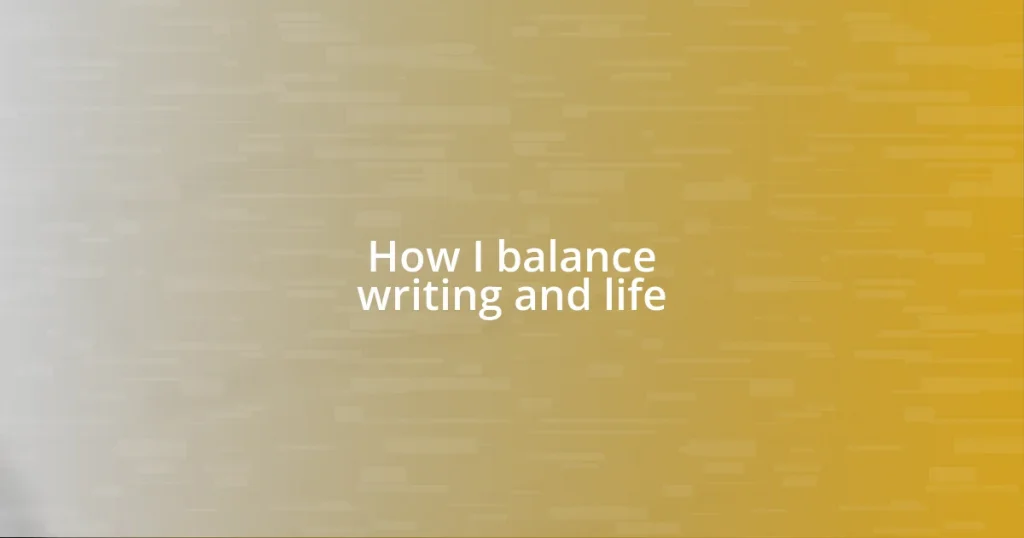Key takeaways:
- Understanding your audience and delivering a clear message enhances engagement and effective communication.
- Practicing speeches and utilizing an organized outline can transform anxiety into confidence and ensure a logical flow.
- Reflecting on past experiences fosters growth, resilience, and self-compassion in public speaking journeys.

Understanding public speaking basics
Understanding the basics of public speaking is crucial for anyone looking to communicate effectively. I remember my first speech vividly; my palms were sweaty, and my heart raced. Did I really need to feel so anxious? Understanding that nervousness is a natural response helped me embrace the experience rather than dread it.
One fundamental aspect of public speaking is knowing your audience. When I first faced a crowd, I realized I had not tailored my content to them. Connecting with listeners makes all the difference—ask yourself, what do they want to hear? This kind of insight transforms a standard presentation into a memorable conversation, engaging the audience on a much deeper level.
Another vital element is clarity of message. Early in my speaking journey, I delivered a talk filled with jargon and complex ideas. It didn’t take long for the audience’s eyes to glaze over. I learned that simplicity is a powerful tool; when I focused on clear and concise messages, viewers not only understood but also retained more of what I said. Wouldn’t you agree that clarity is the bedrock of effective communication?

Preparing for your speech
When it comes to preparing for your speech, I’ve found that practice really makes a difference. I remember rehearsing my first major presentation in front of a mirror, only to discover how awkward I looked! But with each practice round, I became more comfortable. It’s amazing how repetition can transform anxiety into confidence and clarity.
Creating an outline of your key points helps structure your speech logically. I once prepared a speech on a complex topic, and without an outline, I ended up jumping from one thought to another, confusing both myself and my audience. That experience taught me that a well-organized outline acts like a roadmap. It keeps everyone, including myself, on track so we don’t lose sight of the journey.
Visual aids can elevate your presentation, too. During a long-winded talk I gave, I opted for slides that were overwhelming rather than informative. I realized that effective visuals should enhance your message, not distract from it. As you prepare, think about how images or videos might reinforce your points, creating a more engaging experience for listeners.
| Preparation Technique | Personal Experience |
|---|---|
| Practice | Rehearsing helped transform my anxiety into confidence. |
| Outline | An organized outline kept my thoughts and audience on track. |
| Visual Aids | Effective visuals can enhance the message, not distract from it. |

Developing effective communication skills
Developing effective communication skills is a journey that requires constant practice and self-awareness. I recall attending a workshop on communication where the instructor emphasized active listening. At first, I thought I was a good listener, but I soon realized I often focused on what I’d say next rather than truly hearing others. It was a lightbulb moment that pushed me to develop deeper connections in my conversations, leading to richer discussions and responses.
Here’s what I’ve found crucial in honing communication skills:
– Active Listening: Engage with the speaker by nodding or asking follow-up questions. It shows you value their perspective.
– Body Language: Nonverbal cues say more than words. I learned to be mindful of my gestures and expressiveness to enhance my message’s impact.
– Empathy: Understanding others’ emotions can improve rapport. I strive to relate to my audience’s feelings, making my communication more effective.
– Adaptability: Different situations call for different styles. I’ve learned to adjust my approach depending on who I’m speaking with, whether it’s a formal audience or casual friends.
One of my favorite strategies in developing these skills is storytelling. I’ve found that sharing personal experiences resonates deeply with the audience. For instance, during a recent talk on overcoming challenges, I shared a vulnerability about a project that failed despite my efforts. The honesty sparked genuine connections, and I could see their engagement shift from passive to active. Stories can bring points to life, illustrating concepts in ways that data alone often cannot. It’s incredible how a personal touch can make communication not just effective, but profoundly impactful.

Managing anxiety and nervousness
Managing anxiety and nervousness is a common challenge for many speakers, and I’ve certainly felt that knot in my stomach before taking the stage. One time, before presenting at a large conference, I felt almost paralyzed by fear. I discovered breathing techniques that helped ground me. Taking deep, slow breaths reminded me to stay present, creating a calm oasis amid the chaos. Have you ever tried just focusing on your breath? It can be surprisingly grounding.
Visualizing success also played a pivotal role in managing my nerves. Before one of my early presentations, I imagined myself confidently delivering my speech and the audience responding positively. The more vividly I pictured that scene, the less anxious I became. That imaginal rehearsal didn’t just bolster my confidence; it reshaped my mindset, transforming an intimidating situation into a manageable one. Have you ever imagined a successful outcome? It’s a simple yet powerful mental shift.
I’ve learned the importance of acceptance in dealing with public speaking anxiety. The first time I bombed a presentation, I was devastated. But reflecting on that experience taught me that it was part of the process. Embracing the reality that mistakes can happen has made me more resilient. It shifted my focus from fear of failure to embracing growth. After all, every stumble is just a step toward mastery. Isn’t it liberating to know that we can learn and improve from every experience?

Engaging your audience
Engaging your audience is one of the most exciting aspects of public speaking, and I’ve learned that it starts with establishing a connection. I remember a time during a presentation when I noticed a few disengaged faces in the crowd. Instead of sticking strictly to my script, I paused and asked a question directly related to their experiences. The shift was palpable. Suddenly, I could see their eyes light up as they engaged with the topic, transforming the dynamic of the room.
Another effective strategy has been incorporating humor. I once began a presentation about managing workplace stress with a light-hearted anecdote about my own struggles with a notoriously unhelpful coffee machine. The audience chuckled, and I felt an immediate bond form. Humor not only puts the audience at ease, but it also creates a shared experience that can bridge any gaps. Isn’t it fascinating how a simple laugh can open the door to deeper engagement?
Lastly, I’ve discovered the power of asking for participation. During one of my workshops, I invited members of the audience to share their thoughts on a scenario I presented. The moment I did this, the atmosphere changed; everyone began to lean in, eager to contribute. Their responses not only enriched the discussion, but they also made them feel like integral parts of the conversation. Have you ever noticed how engaged you feel when you’re invited to participate? That’s the energy I strive to harness in every talk I give.

Tips for delivering effectively
The key to delivering effectively lies in being authentic. I vividly recall a moment when I let my nerves overshadow my true self during a presentation. I was so focused on sticking to the script that I missed the chance to connect with my audience on a personal level. It was only when I relaxed and let my personality shine through that I noticed the audience leaning in, resonating with my message. Isn’t it refreshing to be real in front of others?
Another impactful tip is to use body language intentionally. During one of my speaking engagements, I consciously made an effort to move around the stage rather than just standing behind the podium. It created a different energy and made me feel more in control. I remember seeing a few audience members nodding and even smiling as I moved closer to them. Have you ever felt a stronger connection with someone who moved around you rather than standing still? It’s amazing how a little movement can create a more engaging atmosphere.
Finally, practice can’t be overlooked. I used to underestimate the power of rehearsal. However, after practicing my speeches out loud, I discovered my pacing and natural pauses improved significantly. I learned to embrace the comfort that comes from repetition, which transformed my anxiety into excitement. Have you ever felt that exhilarating rush when you know your material inside out? It’s a game-changer for effective delivery.

Reflecting on your speaking experience
Reflecting on my speaking experiences often reveals just how much I’ve grown over time. I remember my very first speech; my hands shook, my voice wavered, and I nearly forgot my main points. That nerve-wracking moment taught me that vulnerability can be a strength. It’s okay to feel scared because overcoming it lends authenticity to my message. Have you ever faced a similar hurdle, only to realize how empowering it is to push through?
Looking back, I’ve noticed that each presentation has contributed uniquely to my development. After a particularly challenging talk, I felt overwhelmed by my mistakes, but my audience’s supportive feedback turned my perspective around. That experience highlighted the importance of resilience in public speaking. Isn’t it fascinating how a single interaction can reshape our understanding of our own abilities?
As I reflect on these moments, I can’t help but appreciate the lessons learned about self-compassion. Recognizing that perfection isn’t the goal has freed me from the fear of judgment. Instead of focusing solely on what went wrong, I now celebrate the wins, big and small. Have you allowed yourself the same kindness in your public speaking journey? It’s those small victories that truly build confidence and pave the way for growth.















